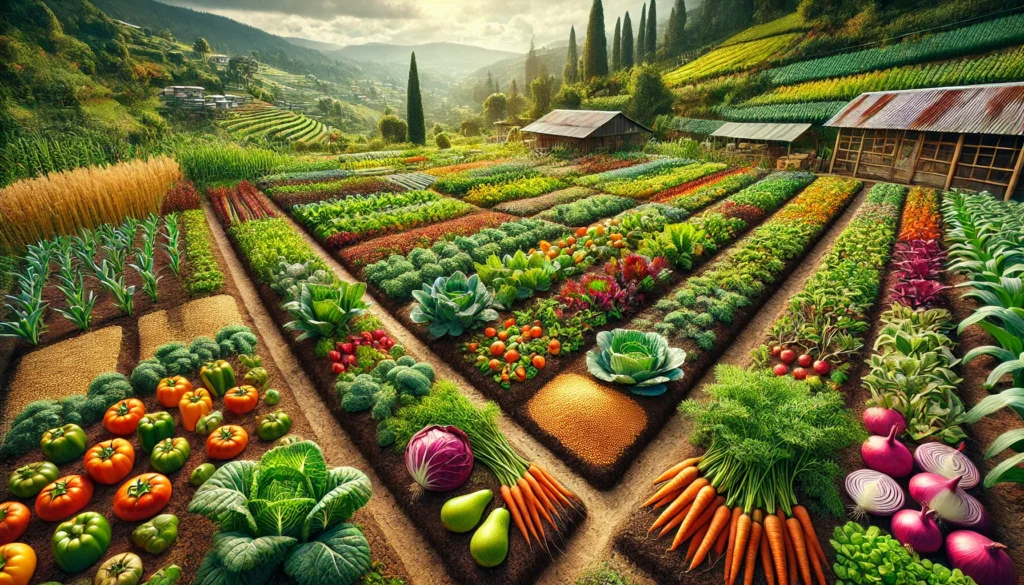Hello, and welcome to a fascinating discussion on carbon farming! This innovative approach to agriculture not only helps farmers but also plays a crucial role in combating climate change. In this blog, we’ll explore what carbon farming is, how it works, and why it’s particularly relevant for India.
What is Carbon Farming?
Carbon farming refers to a set of agricultural practices aimed at capturing and storing carbon dioxide (CO2) from the atmosphere. These practices enhance the soil’s ability to sequester carbon, thus reducing the overall concentration of CO2—a significant greenhouse gas—in the atmosphere.
How Does Carbon Farming Work?
Carbon farming involves various techniques that improve soil health and promote carbon sequestration. These methods include crop rotation, cover cropping, agroforestry, and conservation tillage. By adopting these practices, farmers can increase the organic matter in the soil, which in turn helps capture more carbon.
Why is Carbon Farming Important for India?
With its extensive agricultural areas, India holds significant potential to influence carbon sequestration positively. The country’s farmers can play a crucial role in mitigating climate change while improving soil fertility and crop yields. Let’s delve into some specific practices and their benefits.
Key Carbon Farming Practices
Crop Rotation
Crop rotation involves growing different types of crops in the same area in sequential seasons. This practice helps maintain soil health, reduces pest and disease problems, and enhances carbon sequestration. For instance, rotating legumes with cereals can fix nitrogen in the soil, boosting fertility and promoting carbon storage.
Cover Cropping
Cover crops, like clover or rye, are planted during off-seasons when main crops are not grown. These plants protect the soil from erosion, improve its structure, and add organic matter, which helps sequester carbon. In India, cover cropping can be particularly beneficial during the monsoon season to prevent soil erosion.
Agroforestry
Agroforestry integrates trees and shrubs into agricultural landscapes. This practice not only sequesters carbon but also provides additional benefits like improved biodiversity, soil fertility, and water retention. Farmers in India can plant trees like neem or moringa alongside crops, creating a more resilient farming system.
Conservation Tillage
Conservation tillage minimizes soil disturbance, which helps maintain soil structure and organic matter. Farmers can improve carbon sequestration by lessening how often and how intensely they till the soil. In India, zero-till farming is gaining popularity, especially in regions like Punjab and Haryana.

Benefits of Carbon Farming
Climate Change Mitigation
Carbon farming plays a crucial role in mitigating climate change by capturing CO2 and lowering greenhouse gas emissions. This is crucial for India, a country highly vulnerable to climate impacts like extreme weather events and changing monsoon patterns.
Improved Soil Health
Carbon farming practices enhance soil fertility and structure, leading to better water retention and nutrient availability. Healthier soils result in higher crop yields and more resilient farming systems, which is essential for India’s food security.
Economic Benefits
Carbon farming can provide economic incentives for farmers. Programs that reward carbon sequestration efforts, such as carbon credits, can generate additional income. Moreover, improved soil health and higher yields can reduce input costs and increase profitability.
Real-Life Examples in India
Sikkim’s Organic Revolution
Sikkim, India’s first fully organic state, has embraced carbon farming practices like crop rotation and organic composting. These methods have improved soil health and productivity while contributing to carbon sequestration.
Zero Budget Natural Farming in Andhra Pradesh
Andhra Pradesh’s Zero Budget Natural Farming (ZBNF) initiative promotes practices like mulching, cover cropping, and reduced tillage. This program has not only improved soil health and farmer incomes but also enhanced carbon sequestration.
Challenges and Solutions
Initial Costs and Knowledge Gaps
The initial costs of adopting carbon farming practices can be a barrier for small farmers. Providing financial support and technical training can help overcome these challenges. Government programs and NGOs can play a crucial role in facilitating this transition.
Monitoring and Verification
Accurately measuring and verifying carbon sequestration can be challenging. Developing robust monitoring systems and involving local communities in data collection can improve transparency and effectiveness.
How Can We Support Carbon Farming?
Policy Support
Government policies that promote sustainable agriculture and provide incentives for carbon farming can drive widespread adoption. Subsidies, training programs, and research funding are essential components of such policies.
Community Engagement
Engaging local communities and farmers in carbon farming initiatives is crucial for their success. Farmer cooperatives, community organizations, and extension services can facilitate knowledge sharing and collaboration.
Consumer Awareness
As consumers, we can support carbon farming by choosing products from sustainable sources. Awareness campaigns and certifications can help identify and promote carbon-friendly agricultural products.
Conclusion
Carbon farming offers a promising solution to the dual challenges of climate change and food security. By adopting these practices, Indian farmers can contribute to a more sustainable future while reaping numerous benefits. Let’s support and promote carbon farming for a greener, healthier planet.
Author’s Note:
Thank you for joining me on this journey to understand the importance of carbon farming. I hope this blog motivates you to back up sustainable farming methods and help create a healthier environment. Together, we can make a difference!
G.C., Ecosociosphere contributor.
References and Further Reading:
- . https://letmebreathe.in/2023/06/22/explainer-impact-of-climate-change-on-monsoon-in-india/
- What is Carbon Farming?. https://tracextech.com/resources/glossary/what-is-carbon-farming/
- Regenerative Farming in Practice: A Detailed Look at the Techniques and Benefits of This Sustainable Approach – Catriona’s Kitchen. https://catrionaskitchen.com/regenerative-farming-in-practice-a-detailed-look-at-the-techniques-and-benefits-of-this-sustainable-approach/
- From Farm to Fork: Exploring Sustainable Agriculture Practices for a Greener Future -. https://latam-translations.com/from-farm-to-fork-exploring-sustainable-agriculture-practices-for-a-greener-future/
- Eco-warriorsððSeries: Natalie C @ V’air Co-Founder & part of the Council of Sustainable Dev.. https://www.localhood.org/single-post/celebrating-women-series-natalie-c-v-air-co-founder-part-of-the-council-of-sustainable-dev
- Cover Crops for Regenerative Farming | Cover Cropping Guide for Agriculture – Carnivore Snax. https://carnivoresnax.com/blogs/articles/cover-crops-for-regenerative-farming
- Unveiling the Invisible Struggle: The Resilience of Small-Scale Coffee Farmers – TechBullion. https://techbullion.com/unveiling-the-invisible-struggle-the-resilience-of-small-scale-coffee-farmers/
- Farmer led initiative to help farmers adapt to climate change. https://pacificfarmers.com/farmer-led-initiative-to-help-farmers-adapt-to-climate-change/
- Corporate Social Responsibility Propelling Renewable Energy Transformation – Flux. https://fluxfair.nyc/corporate-social-responsibility-propelling-renewable-energy-transformation/




